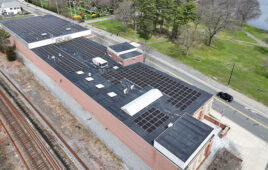
Photo: Sollega
Hybrid flat-roof solar mounting systems offers advantages in areas with seismic conditions or high wind loads. Hurricane-prone areas, buildings more than 60-ft tall and island installations are examples of these areas. Hybrid systems prevent loading the roof down with high amounts of ballast, which many roof structures cannot support. A mixture of attachments and ballast can be used to keep roof weights low.
“In California and other places of high seismic activity we use a hybrid system,” said Elie Rothschild, sales manager at Sollega. “The other time we use a hybrid system is when the ballast requirements for wind uplift exceed the available structural reserve of the roof. We can replace ballast with anchors where necessary.”
In addition, hybrid systems can reduce the labor and material costs associated with installing a conventional raised racking system requiring a lot of roof attachments. Roof attachments can be expensive and typically need to be installed and flashed by a roofer to maintain a roof warranty, Rothschild said.
Mounting manufacturer Unirac supplied a hybrid system for the 6.2-MW installation at Mandalay Bay resort and casino in Las Vegas. Attachments were used to keep the roof weight low on buildings that were over 100-ft tall and had extreme wind loading conditions.
Unirac product manager Bill Vaught said contractors should consider these questions when deciding whether to use a hybrid system:
- What additional roof weight can the building structurally handle?
- Is there a non-penetrating system that can meet this weight requirement with the design wind load, roof height and exposure category of the project?
- What roof type does the project have?
- If the project has a membrane roof, how is it attached?
- How many attachments does the project need? The racking supplier should be able to provide this information.
- What kind of attachment should I use?
If contractors decide to use a hybrid system, attachments to flat-roof systems must be handled with care by an experienced installer. The best way to avoid leaks and issues with roof warranties is to use a reputable attachment manufacturer that has done testing in collaboration with roofing manufacturers, and to install per manufacturer guidelines.
“We typically recommend a ‘heat-welded’ type attachment for the majority of roofs, such as those provided by Anchor Products and OMG Roofing Products,” Vaught said.
And as is always the case with any type of solar installation, it’s important to ensure the roof is sound before installing solar. It’s much more difficult to repair or track the source of leaks after a solar array is installed.
“We recommend to all our clients that they follow the guidelines established by the roofing manufacturers—and each have their own—to maintain the roof warranty,” Rothschild said.





Could you please indicate me a manufacturer that can provide us the a device like Unirac. I have seen the the Unirac device is not available now